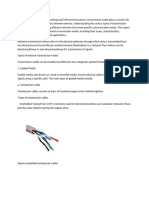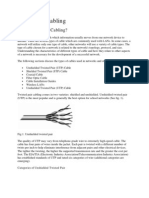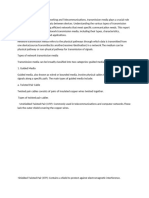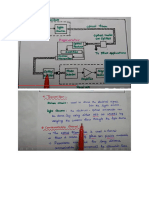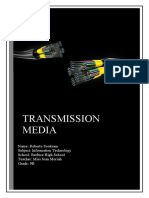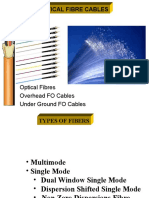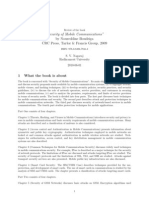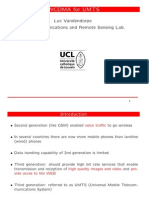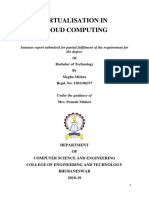OFC Applications Guidelines
OFC Applications Guidelines
Uploaded by
vijay_786Copyright:
Available Formats
OFC Applications Guidelines
OFC Applications Guidelines
Uploaded by
vijay_786Original Description:
Copyright
Available Formats
Share this document
Did you find this document useful?
Is this content inappropriate?
Copyright:
Available Formats
OFC Applications Guidelines
OFC Applications Guidelines
Uploaded by
vijay_786Copyright:
Available Formats
OPTICAL FIBRE CABLE APPLICATIONS GUIDELINES
Introduction:
The use and demand for optical fibre has grown up tremendously and the applications of
optical-fibre are numerous. Telecommunication applications are widespread, ranging from
global networks to desktop computers. These involve the transmission of voice, data, or
video over distances of less than a meter to hundreds of kilometres, using one of a few
standard fibre designs in one of several cable designs. Optical Fibre cables are being laid in
large quantity for transportation of signals in long distance and in junction network.
Carriers use optical fibres to carry Plain Old Telephone Service (POTS) across their
nationwide and international networks. Local exchange carriers use fibres to carry the same
service between central office switches at local levels, and sometimes as far as the
neighbourhood or individual home using Fibre to the Home (FTTH) network.
Optical fibre is also used extensively for transmission of data. National and multinational
network providers need secure reliable systems to transfer data and financial information
between buildings to the desktop terminals or computers and to transfer data around the
world. Cable television companies also use optical fibres for delivery of digital video and
data services. The high bandwidth provided by optical fibre makes it the perfect choice for
transmitting broadband signals, such as high-definition television (HDTV) telecasts.
Optical cables are designed to protect the contained optical fibres from damage due to the
rigors of installation and from the hazards of the surrounding environment. Cable designs
can also be optimized to facilitate installation. However, no single optical cable design is
universally superior in all applications. In general, optical fibre cables installed in an
outdoor environment are exposed to more severe mechanical and environmental conditions
than are experienced in the protected, climate-controlled indoor environment. Outdoor
installations are also subjected to combinations of hazards of ultraviolet (UV) radiation,
standing water, cable-gnawing rodents, termites, and temperature extremes. Whether the
cable is to be installed aerially, directly-buried, or jetted into a duct will determine which
cable type is best suited to an outside plant installation.
Different types of construction designs for the manufacturing of optical fibre cables are in
practice (depending upon its method of deployment, usage and the installation methods).
Following are the few types of the Optical fibre cable design based on the installation
method:
I. Metal Free Optical Fibre Cable (Underground Installation - Duct):
This type of cable is mechanically weak and is normally installed in underground
ducts. The cable may be of Multi-Loose Tube construction type. The underground
installation of optical fibre cable is basically done either by directly buried or in a
duct. HDPE ducts/pipes are first laid in a trench and then cables are pulled in
manually or are blowed in. Following are the few types of the Metal free Optical Fibre
Cable for Underground Duct Installation:
1
1. Metal-Free Optical Fibre Cable - Used for Local and Trunk networks
2. High Count Metal Free Optical Fibre Cable (Ribbon Type for Access Network) -
Used for Access Networks
3. Non Zero Dispersion Shifted Single Mode Metal Free Optical Fibre Cable - Used
for SDH and DWDM systems for long haul transmission in the networks.
4. Optical fibre cable for Coastal Areas & High sub-soil water condition - Used in
Coastal areas and sub-soil water conditions.
5. Metal-Free Optical Fibre Cable (G.652 D Fibre) - Used for Local and Trunk
networks.
6. Non-Zero Dispersion Optical Fibre Cable for Wideband Optical Transport (G.656
Fibre) Used for Wideband Optical Transport carrying DWDM signals for long
haul transmission
7. Armoured Optical Fibre Cable for Duct application Used for Local and Trunk
networks.
The detailed constructional design and features of the cables are specified in
Annexure-I.
II. Armoured Optical Fibre Cable (Underground Installation - Directly
Buried): The Armoured Optical Fibre Cable of Multi-Loose Tube construction type
is mechanically protected by corrugated armour. The cable may be installed directly
buried in the ground at a proper depth or installed in the ducts. Following are the few
types of the Armoured Optical Fibre Cable for Underground - Direct Burial:
1. Armoured Optical Fibre Cable for Direct Burial (Underground) - Used for Local
and Trunk networks
2. High Count Armoured Optical Fibre Cable (Ribbon Type for Access Network) -
Used for Access Networks
3. Non Zero Dispersion Shifted Single Mode Armoured Optical Fibre Cable - Used
for SDH and DWDM systems in the networks.
4. Optical Fibre Cable for Concrete surfaces - Used under concrete surfaces.
The detailed constructional design and features of the cables are specified in
Annexure-II.
III. Aerial Optical Fibre Cables (Aerial Installation): The aerial installation
normally uses the poles or towers with special types of Fixtures & Accessories to
support the optical fibre cable. The Aerial Optical fibre cables may be of Self-
supporting Metal-Free type, or may have armouring for more mechanical protection.
Following are the few types of the Optical Fibre Cable for Aerial installation:
1. Self-Supporting Metal-Free Aerial Optical Fibre Cable (For Hilly & Rural areas) -
Used between two points on the aerial alignment in Hilly & Rural areas with
maximum span length of 100 meters.
2. Self-Supporting Metal-Free Aerial Optical Fibre Cable (For Urban areas). - Used
between two points on the aerial alignment between the poles or pole to building
in the urban areas with maximum span length of 75 meters.
2
The detailed constructional design and features of the cables are specified in
Annexure-III.
IV. Fibre-to-the-Home (FTTH) Optical Fibre Cables: Optical fibre networks
servicing FTTH systems rely upon outside plant cables to ensure high quality, reliable
service to the subscribers. Last-mile connectivity in FTTH for each subscriber is
achieved through indoor cables, viz. Simplex, Duplex, Mini cables, etc. All these
cables are designed to withstand the environment for indoor, mainly equipped with
fire retardant and tighter bending properties. Since the cable deployed indoors is
subjected to sharp bends, bend insensitive optical fibres are preferred over
conventional fibres. Moreover, the outer jacket is generally made of fire resistant
materials, like Low Smoke Zero Halogen (LSZH) etc. The last mile connectivity
cables are also designed for easy connectorization, enabling easy maintenance at the
user premises. Following are the few types of the Optical Fibre Cable for FTTH
applications:
1. Outdoor Drop Optical Fibre Cable (Figure 8 Type) Used as Outdoor cable for
installing between two poles and a pole to building.
2. Flexible Optical Fibre Cable (For Indoor Applications) Used as Indoor cable
for interconnecting/drop/distribution cabling purpose within a high rise building.
3. Optical Fibre Drop Cable - Used as Indoor as well as Outdoor cable for
installation between two poles and inside home.
4. Micro Duct Optical Fibre Cable Used for installation in Micro-ducts by
blowing method.
5. Optical Fibre Cable for FTTH application (G.657 A Fibre) Used as Indoor
cable for installing inside the premises/buildings for FTTx applications,
employing bending loss-insensitive optical fibre.
The detailed constructional design and features of the cables are specified in
Annexure-IV.
V. Optical Fibre Cables for laying over Power Lines: These cables are
installed on the overhead power distribution network. Following are the few types of
the Optical Fibre Cable for laying over Power Line.
1. All-Dielectric Self-supporting (ADSS) Optical Fibre Cable for laying on power
line alignments - To be installed on the overhead power distribution network up
to 33 KV.
2. Optical Ground Wire (OPGW) Cable for laying on power lines) - To be installed
on existing high voltage Power Line alignments beyond 33 KV, up to 400 KV.
The cable may also replace the existing Ground Wire of the alignment.
The detailed constructional design and features of the cables are specified in
Annexure-V.
3
ANNEXURE-I
1. METAL FREE OPTICAL FIBRE CABLE
Description:
Multi-Loose tube Single J acket Optical Fibre Cable is meant for Underground Duct
Installation. Extra protection is provided by Nylon as outermost layer which also ensures
termite resistance. This cable is metal-free and hence, there is no need to ground the cable.
Features:
Available in fibre counts from 6 F, 12 F, 24 F & 48 F.
Recommended for Underground Duct Installation only.
Strain-free fibre due to S-Z stranding and loose tube design.
Longitudinal water protection enabled by water blocking compounds in tube and core.
Easy Mid-span access because of Multi tube design.
Extra protection provided by Nylon as outermost sheath.
Note: This is recommended for Long Haul/ Short haul networks.
Application: Under-Ground, Duct
Cross-Sectional Diagram:
4
2. HIGH COUNT METAL-FREE OPTICAL FIBRE CABLE (RIBBON
TYPE FOR ACCESS NETWORK) - USED FOR ACCESS
NETWORKS
Description:
Multi tube Single J acket Ribbon Optical fibre Cable is meant for Underground Duct
Installation. Extra protection is provided by Nylon as outermost layer which also ensures
termite resistance. This cable is metal-free and hence, there is no need to ground the cable.
The fibre ribbon combines robust performance for duct installations with the productivity of
high-count mass fusion splicing. The optical fibres are arranged into ribbon units by placing
the fibres in a flat array of 12 colour-coded fibres bonded together by a UV- cured matrix
material.
Features:
Available in fibre counts from 48 F, 96 F, 144 F, 288 F & 576 F.
Precise fibre and ribbon geometries result in excellent mass-fusion splicing yields.
Recommended for Underground Duct Installation only.
Strain free fibre due to S-Z stranding and loose tube design
Longitudinal water protection enabled by water blocking compounds in tube and core.
Easy Mid-span access because of Multi tube design.
Extra protection provided by Nylon as outermost sheath.
Note: This is recommended for access network.
Application: Under-Ground, Duct
Cross-Sectional Diagram:
5
3. NON-ZERO DISPERSION SHIFTED SINGLE MODE METAL-
FREE OPTICAL FIBRE CABLE (NZDS) - (G.655 C FIBRE)
Description:
Multi-tube Single J acket Optical fibre Cable is meant for Underground Duct Installation.
Extra protection is provided by Nylon as outermost layer which also ensures termite
resistance. This cable is metal-free and hence, there is no need to ground the cable. This
cable is envisaged to be installed in the ducts and meant to carry high bit rate optical signals
including DWDM signals.
Features:
Available in fibre counts from 12 F, 24 F, 48 F & 96 F.
Recommended for Underground Duct Installation only.
Strain-free fibre due to S-Z stranding and loose tube design
Longitudinal water protection enabled by water blocking compounds in tube and core.
Easy Mid-span access because of Multi-tube design.
Extra protection provided by Nylon as outermost sheath.
Note: This is recommended for Long Haul/ Back bone networks for longer link lengths
as lesser number of dispersion compensators are required for NZDSF fibre.
Application: Under-Ground, Duct
Cross-Sectional Diagram:
6
4. OPTICAL FIBRE CABLE FOR COASTAL AREAS & HIGH SUB
SOIL WATER CONDITION - USED IN COASTAL AREAS
Description:
Multi-tube Single J acket Poly Aluminium Cable is multipurpose cable designed for diverse
needs. Polymer coated Aluminium tape and Flooding J elly makes this cable moisture-proof,
and Glass Roving yarn adds to tensile strength. This cable is metal-free and hence, there is
no need to ground the cable.
Features:
Available in fibre counts from 6 F, 12 F, 24 F & 48 F.
Moisture protected cable due to Polymer coated Aluminium Tape.
Strain free fibre due to S-Z stranding and loose tube design.
Longitudinal water protection enabled by water blocking compounds in tube and core.
Easy Mid-span access because of Multi-tube design.
Note: This is recommended for Long Haul/ Short haul networks in Coastal areas and
sub soil water conditions.
Application: Under-Ground, Duct / Coastal areas
Cross-Sectional Diagram:
7
5. METAL-FREE OPTICAL FIBRE CABLE (G.652 D FIBRE)
Description:
Multi-tube Single J acket Optical Fibre Cable is meant for Underground Duct Installation.
Extra protection is provided by Nylon as outermost layer which also ensures termite
resistance. This cable is metal-free and hence, there is no need to ground the cable.
Features:
Available in fibre counts from 6 F, 12 F, 24 F & 48 F.
Recommended for Underground Duct Installation only.
Strain-free fibre due to S-Z stranding and loose tube design
Longitudinal water protection enabled by water blocking compounds in tube and core.
Easy Mid-span access because of Multi-tube design.
Extra protection provided by Nylon as outermost sheath.
Note: This is recommended for Long Haul/ Short haul networks.
Application: Under-Ground, Duct
Cross-Sectional Diagram:
8
6. NONZERO DISPERSION OPTICAL FIBRE CABLE FOR
WIDEBAND OPTICAL TRANSPORT (G. 656 FIBRE)
Description:
Multi-tube Single J acket Optical fibre Cable is meant for Underground Duct Installation.
Extra protection is provided by Nylon as outermost layer which also ensures termite
resistance. This cable is metal-free and hence, there is no need to ground the cable. It is
fully compatible with existing NZDS fibre and also supports long haul transmission
compatible with S, C and L bands. It provides lower attenuation at 1400 nm wavelength
region and efficiently supports CWDM cheap transmission system at 10 Gb/s and 40 Gb/s.
It provides longest uncompensated reach (~200 km) in metropolitan network, resulting in
cost saving compared to conventional single mode fibre.
Features:
Available in fibre counts from 6 F, 12 F, 24 F & 48 F.
Recommended for Underground Duct Installation only.
Strain-free fibre due to S-Z stranding and loose tube design
Longitudinal water protection enabled by water blocking compounds in tube and core.
Easy Mid-span access because of Multi-tube design.
Extra protection provided by Nylon as outermost sheath.
Note: This is recommended for Long Haul/ Back bone networks for longer link lengths
as lesser number of dispersion compensators are required.
Application: Under-Ground, Duct
Cross-Sectional Diagram:
9
7. ARMOURED OPTICAL FIBRE CABLE FOR DUCT APPLICATION
(G.652 D Fibre)
Description:
Multi-tube Single J acket Metallic Armoured Cable is multipurpose cable designed for
diverse needs. This design is robust and suitable for duct installation. This design is
available with Wet core as well as Semi-Dry Core. Semi-Dry core design is lighter in
weight and will take lesser time for maintenance & installation. This design is suitable and
recommended for installation in duct in Indian tropical conditions.
Features:
Available in fibre counts from 6 F, 12 F, 24 F, 48 F & 96 F.
Easy to Install due to Semi dry core design and easy to peel but rugged PE jacket.
Rodent protection due to Corrugated Steel Tape Armour.
Strain-free fibre due to S-Z stranding and loose tube design.
Longitudinal water protection enabled by water blocking compounds in tube and core.
Easy Mid-span access because of Multi-tube design.
Recommended for Long Haul/ Short haul networks.
Note: This cable has to be grounded as it contains metal.
Application: Under Ground Duct
Cross-Sectional Diagrams:
Semi DryCore
Wet Core
10
ANNEXURE-II
1. ARMOURED OPTICAL FIBRE CABLE FOR DIRECT BURIAL
(UNDERGROUND)
Description:
Multi-tube Single J acket Metallic Armoured Cable is multipurpose cable designed for
diverse needs for added tensile strength. It has two embedded strength members in outer
sheath as stainless wires which are diametrically opposite to each other. Its robust design
withstands the most demanding environment of direct burial.
Features:
Available in fibre counts from 6 F, 12 F, 24 F & 48 F.
Direct Burial Installation due to double sheath and Corrugated Steel Tape.
Rodent protection in-spite of Direct Burial Application due to Corrugated Steel Tape.
Strain-free fibres due to S-Z stranding and loose tube design
Longitudinal water protection enabled by water blocking compounds in tube and core.
Easy Mid-span access because of Multi-tube design
Two Stainless Steel wires diametrically opposite to each other in outer sheath, add to
tensile strength.
Recommended for Long Haul / Back bone networks.
Note: This cable has to be grounded as it contains metal.
Application: Under Ground, Direct Buried
Cross-Sectional Diagram:
11
2. High Count Armoured Optical Fibre Cable (Ribbon Type) For Access
Network
Description:
Multi-tube Single J acket Metallic Armoured Cable is multipurpose cable designed for
diverse needs for added tensile strength. It has two embedded strength members in outer
sheath as stainless wires which are diametrically opposite to each other. Its robust design
withstands the most demanding environment of direct burial.
The Ribbon fibre combines robust performance for direct buried installations with the
productivity of high-count mass fusion splicing. The optical fibres are arranged into ribbon
units by placing the fibres in a flat array of 12 colour-coded fibres bonded together by a
UV-cured matrix material.
Features:
Available in fibre counts from 48 F, 96 F, 144 F, 288 F & 576 F.
Direct Burial Installation due to double sheath and Corrugated Steel Tape.
Rodent protection in-spite of Direct Burial application due to Corrugated Steel Tape.
Strain-free fibres due to S-Z stranding and loose tube design
Longitudinal water protection enabled by water blocking compounds in tube and core.
Easy Mid-span access because of Multi-tube design
Two Stainless Steel wires diametrically opposite to each other in outer sheath add to
tensile strength.
Recommended for Access networks.
Note: This cable has to be grounded as it contains metal.
Application: Under Ground, Direct Buried
Cross-Sectional Diagram:
12
3. Non-Zero Dispersion Shifted Single Mode Armoured Optical Fibre
Cable
Description:
Multi-tube Single J acket Metallic Armoured Cable is multipurpose cables designed for
diverse needs for added tensile strength. It has two embedded strength members in outer
sheath as stainless wires which are diametrically opposite to each other. Its robust design
withstands the most demanding environment of direct burial. This cable is meant to carry
high bit rate optical signals including DWDM signals.
Features:
Available in fibre counts from 12 F, 24 F, 48 F & 96 F.
Direct Burial Installation due to double sheath & Corrugated Steel Tape.
Rodent protection in spite of Direct Burial application due to Corrugated Steel Tape
Strain-free fibre due to S-Z stranding and loose tube design
Longitudinal water protection enabled by water blocking compounds in tube and core.
Easy Mid-span access because of Multi-tube design.
Two Stainless Steel wires diametrically opposite to each other in outer sheath add to
tensile strength.
Recommended for Long Haul/ Back bone networks for longer link lengths as lesser no.
of dispersion compensators are required for NZDSF fibre.
Note: This cable has to be grounded as it contains metal.
Application: Under Ground, Direct Buried
Cross-Sectional Diagram:
4. UNDERGROUND DIRECT BURIED CABLE (CONCRETE
SURFACE)
13
Description:
Uni-tube Single J acket FRP Armoured Cables is multipurpose cable designed for a very
specific application. In this stranding of FRPs is done over central tube to protect the cable
which is then wrapped with polyester tape. J acketing is done with PE which is finally
protected with Nylon 12. Nylon ensures termite resistance. This cable is metal-free and
hence, there is no need to ground the cable.
Features:
Available in fibre counts from 6 F, 12 F, 24 F & 48 F.
Direct Burial Installation due to FRP Armouring.
Installed in concrete surface by making trenches in it.
Longitudinal water protection enabled by water blocking compounds in tube and core.
Suitable for drop application because of Uni-tube design.
Recommended for Long Haul/ Short haul networks.
Note: This is recommended for Concrete surfaces.
Application: Under Ground, Direct Buried/Concrete Surface
Cross-Sectional Diagram:
14
ANNEXURE-III
1. SELF SUPPORTING METAL FREE AERIAL OPTICAL FIBRE CABLE (FOR
HILLY & RURAL AREAS) - (G.652 D FIBRE)
Description:
Multi-tube Double J acket All-Dielectric Self-Supporting (ADSS) cable is multipurpose
cable designed for diverse needs. Its robust design and high tensile strength makes it
suitable for Aerial application. This cable can be installed between two points on the aerial
alignment in Hilly & Rural areas with maximum span length of 100 m. This cable is metal-
free and hence, there is no need to ground the cable.
Features:
Available in fibre counts from 6 F, 12 F, 24 F & 48 F.
Double sheath protection ensures better protection.
Can be installed on telephone poles/poles.
Strain-free fibre due to S-Z stranding and loose tube design.
Longitudinal water protection enabled by water blocking compounds in tube and core.
Easy Mid-span access because of Multi-tube design.
Recommended for Long Haul/ Short haul networks.
Note: These cables can be installed on power transmission line alignments (up to
11 KVA).
Application: Recommended for Aerial/ Hilly & Rural Areas
Cross-Sectional Diagram:
15
2. SELF SUPPORTING METAL-FREE AERIAL OPTICAL FIBRE CABLE (FOR
URBAN AREAS) - (G.652 D FIBRE)
Description:
Multi-tube Single J acket All-Dielectric Self-Supporting (ADSS) cable is multipurpose cable
designed for diverse needs. Its robust design and high tensile strength makes it suitable for
Aerial application. This cable can be installed between two points on the aerial alignment
(between the poles or pole to building) in urban areas with maximum span length of 75 m.
This cable is metal-free and hence, there is no need to ground the cable.
Features:
Available in fibre counts from 6 F, 12 F, 24 F & 48 F.
Can be installed on telephone poles/poles.
Strain-free fibre due to S-Z stranding and loose tube design
Longitudinal water protection enabled by water blocking compounds in tube and core.
Easy Mid-span access because of Multi-tube design.
Recommended for Long Haul/ Short haul networks.
Note: These cables can be installed on power transmission line alignments (up to
11 KVA).
Application: Recommended for Aerial/Urban Areas
Cross-Sectional Diagram:
16
ANNEXURE-IV
1. OUTDOOR OPTICAL FIBRE DROP CABLE (FIGURE-8 TYPE) (G.652 D
FIBRE)
Description:
Outdoor Optical Fibre Cable is a drop cable with Uni-tube construction with Figure Eight
(8) design. It is suitable for installing between two poles and a pole to building. The cable is
light weight and flexible. It has good mechanical protection with stable temperature
performance conditions to withstand varying environmental conditions due to exposure in
open. As this cable contains metal there is a specific need to ground the cable.
Features:
Fibre design is available in fibre counts of 4 F, 6 F, 8 F, 12 F, 16 F & 24 F.
Ribbon fibre design is available in fibre counts of 4 F.
Use of Stainless Steel wire makes it suitable for Aerial installation.
Aramid yarns around central tube adds to tensile strength.
Can be hanged from Pole to Building & Pole to pole.
ARP provides more tensile strength and stiffness.
Loose buffered construction keeps fibres strain-free.
Uni-tube design for drop application and faster installation.
Note: This is recommended for Short haul FTTH networks.
Application: Outdoor FTTH/ Last Mile / Aerial Drop
Cross-Sectional Diagrams:
17
12 Fibre Cable Design
4 Fibre Ribbon Cable Design
18
2. FLEXIBLE OPTICAL FIBRE CABLE (FOR INDOOR APPLICATIONS) -
(G.652 D FIBRE)
Description:
Flexible Optical Fibre cable is for indoor applications. This cable is suitable for inter-
connecting/drop/distribution cabling purpose within the high rise building and has excellent
flexibility required for routing through various turns/curves ensuring fast and easy
installation. The optical fibre cable is protected with yellow colour Low smoke zero
Halogen (LSZH) sheath. Aramid Yarns reinforcement is done to provide tensile strength to
the cable.
Features:
Fibre design is available in fibre counts 2 F, 4 F, 6 F, 8 F & 12 F.
Duplex design is for 2 F, and higher count cables are for distribution.
To be installed within building premises only.
Aramid yarns around central tube adds to tensile strength.
Easy to connectorise due to Tight buffered construction.
Note: This is recommended for FTTH networks.
Application: Indoor/ FTTH /Last-Mile)
Cross-Sectional Diagrams:
2 F Duplex Cable Design
19
4 F Cable Design
20
3. OPTICAL FIBRE DROP CABLE (INDOOR/OUTDOOR) - (G.652 D
FIBRE)
Description:
Optical fibre installation cable is a drop cable with Uni-tube construction. It can be hanged
on poles. Ruggedized construction is for excellent installation performance, easily
strippable for fast installation. This can be installed inside building. This can also install
from pole to pole. As this cable contains metal there is a specific need to ground the cable.
Features:
These are available in fibre counts 2 F, 4 F & 6 F.
Use of FRP makes it suitable for Aerial installation.
Can be hanged from Pole to pole and inside building.
ARP provides more tensile strength and stiffness.
Loose buffered construction keeps fibre strain-free.
Uni-tube design for drop application and faster installation.
Note: This is recommended for Short haul FTTH networks.
Application: Indoor/Outdoor FTTH/Last Mile/Aerial Drop
Cross-Sectional Diagram:
21
4. MICRO DUCT OPTICAL FIBRE CABLE (G.652 D FIBRE)
I. Uni -Tube design:
Description:
Uni-tube Single J acket Micro cable is envisaged to be installed in the Micro Ducts. Micro
ducts can also be installed in previously installed ducts. Its uni-tube design with lesser
diameter makes it lighter in weight and easy to install by blowing method. This cable is
metal-free and hence, there is no need to ground the cable.
FRP provides desired stiffness and anti-buckling effect for the cable so that it can be blown
in micro duct. This cable is suitable for Drop application with installation by blowing
method.
Features:
Available in fibre counts from 6 F, 12 F & 24 F
FRP as Embedded strength member increases Anti-Buckling property.
Suitable for installation in Micro ducts by blowing method.
Can be installed in Pre-installed ducts by blowing in Micro ducts.
Strain-free fibre due Uni-tube design
Longitudinal water protection enabled by water blocking compounds in tube
Note: This is recommended for Short haul FTTH networks/Long Haul networks.
Application: Recommended in Micro ducts for Indoor/Outdoor FTTH/Last Mile
Cross-Sectional Diagram:
22
II Multitube design:
Description:
Multi-tube Single J acket Micro cable is envisaged to be installed in the Micro Ducts. Micro
ducts can also be installed in previously installed ducts. Its lesser diameter makes it lighter
in weight and easy to install by blowing. This cable is metal-free and hence, there is no
need to ground the cable.
Features:
Available in fibre counts from 48 F & 72 F.
High fibre density.
Installed in Micro Duct by blowing.
Can be installed in Pre-installed ducts by blowing in Micro ducts.
Strain-free fibre due to S-Z stranding and loose tube design.
Longitudinal water protection enabled by water blocking compounds in tube and core.
Easy Mid-span access because of Multi tube design.
Note: This is recommended for Short haul FTTH networks/Long Haul networks.
Application: Recommended in Micro ducts for FTTH networks /Long Haul networks.
Cross-Sectional Diagram:
OUTER JACKET (NYLON)
CENTRAL MEMBER (FRP ROD)
POLYESTER BINDER
LOOSE TUBE WITH FIBRES
23
5. OPTICAL FIBRE CABLE FOR FTTH APPLICATION (G.657A)
Description:
This is Metal-free Optical Fibre Cable, using optical fibre conforming to the ITU-T
Rec. 657.A for FTTx applications. This cable is to be installed inside the premises/buildings
and meant to carry high bit rate optical signals to the end user. The optical fibre being used
is bending loss-insensitive which is suitable for fibre to the home application. These cables
have low weight, small volume and high flexibility. The optical fibre cable is protected with
Low Smoke Zero Halogen (LSZH) sheath. This cable is metal-free and hence, there is no
need to ground the cable.
Features:
Flat cable design for 1F & 2F.
Uni-tube design for higher fibre count 1F to 12F.
To be installed within building premises.
Can be connectorized and terminated in field.
G.657 fibre makes its in-building installation easier.
Note: This is recommended for FTTH networks.
Application: Indoor/ FTTH Last Mile
Cross-Sectional Diagrams:
2F Flat Cable Design
2F Uni-tube Cable Design
24
ANNEXURE-V
1. ADSS OPTICAL FIBRE CABLE FOR LAYING ALONG POWER
LINE ALIGNMENTS (G.652 D FIBRE)
Description:
Multi-tube Double J acket All-Dielectric Self Supporting (ADSS) cable is multipurpose
cable designed for diverse needs. Its robust design and high tensile strength makes it
suitable for Aerial application. Dielectric strength member and Anti tracking compound in
outer sheath makes it suitable for installation on power lines up to 33 KV. Its Semi dry core
cable design makes it light weight and easy to install. This cable can be installed for span
length of 100 m. This cable is metal-free and hence, there is no need to ground the cable.
Features:
Available in fibre counts from 24 F, 48 F & 96 F.
Can be installed with Power lines up-to 33 KV.
Anti tracking compound in outer sheath resists dry band arcing.
Easy to install due to dry core design & easy to peel, but rugged PE jacket.
Strain-free fibre due to S-Z stranding and loose tube design.
Longitudinal water protection enabled by water blocking compounds in tube and core.
Easy Mid-span access because of Multi tube design.
Application: ADSS on Power transmission lines (up-to 33 KV Lines)
Cross-Sectional Diagrams:
Wet Core Cable Design
25
Semi Dry Core Cable Design
26
2. OPTICAL GROUND WIRE (OPGW) FOR LAYING ALONG POWER LINES
(G.652 D & G.655 FIBRE)
Description:
Optical Ground Wire Cable is for installation on EHV Transmission lines, up to 400 KV.
The cable performs the dual functions of Earth Wire and Optical Fibre Cable. The cable has
good mechanical protection with stable temperature performance, as it can be exposed to
varying environmental conditions. The cable may also be a replacement to the existing
Ground Wire of the system, with no modifications to the Towers.
The OPGW cable is intended to be installed on the new or existing overhead power
distribution networks of more than 33 KV and up to 400 KV. The constructional design of
Cable Core assembly (Stainless steel loose tube) has been specified, as the design of
complete cable depends on a number of variables, viz., electrical, mechanical and physical
characteristics of existing alignments and towers.
Features:
Available in 24 F.
Can be installed on Transmission lines of more than 33 KV and up-to 400 KV.
Construction of OPGW cable depends on the electrical and mechanical characteristics
of existing alignments and will be different for different power line voltages, fault
current, and span lengths, etc.
The design of the cable also varies with the physical characteristics of towers.
Application: OPGW on Power transmission lines of more than 33 KV and up-to 400 KV
Lines
Cross-Sectional Diagram:
27
You might also like
- ID CAT Company - Name Email Phone - Number Address CityDocument1,152 pagesID CAT Company - Name Email Phone - Number Address CityWaf EtanoNo ratings yet
- Guide Lines For GPON PlanningDocument34 pagesGuide Lines For GPON PlanningAnish Veettiyankal100% (2)
- 5G Antenna PDFDocument34 pages5G Antenna PDFAshutosh ShakyaNo ratings yet
- Moamal Fiberoptic1Document8 pagesMoamal Fiberoptic1qaswwww92No ratings yet
- Moamal Fiberoptic1Document8 pagesMoamal Fiberoptic1cicero juarezNo ratings yet
- Optical Fiber CommunicationsDocument6 pagesOptical Fiber CommunicationsSaurabh RajNo ratings yet
- Practical 2Document7 pagesPractical 2umair riazNo ratings yet
- Chapter 4 11TH CLASS Unit 1Document9 pagesChapter 4 11TH CLASS Unit 1rajindertelecomnsqfNo ratings yet
- Fibre Optcs BasicDocument23 pagesFibre Optcs BasicAshmieu SesayNo ratings yet
- Santron Electronics ProfileDocument35 pagesSantron Electronics ProfileprakashbancyNo ratings yet
- Networking CablesDocument5 pagesNetworking CablesrohanaviNo ratings yet
- Guide Lines For GPON PlanningDocument34 pagesGuide Lines For GPON PlanningOmar AwaleNo ratings yet
- Module 3 Telecom Osp InstallationDocument12 pagesModule 3 Telecom Osp InstallationJomer Baquilod100% (1)
- FOC - FundamentalsDocument5 pagesFOC - FundamentalsCynthia PlazaNo ratings yet
- Simplifying The Migration From Copper To FiberDocument8 pagesSimplifying The Migration From Copper To FiberNilesh RoyNo ratings yet
- Coaxial and FiberDocument16 pagesCoaxial and Fibersenkuk6No ratings yet
- Document 3Document17 pagesDocument 3Night FuryNo ratings yet
- Running Head: NETWORK MEDIA: Case Study: Types of Network Media SCT 121-C004-0454/2019 DITDocument7 pagesRunning Head: NETWORK MEDIA: Case Study: Types of Network Media SCT 121-C004-0454/2019 DITIANNo ratings yet
- Report??Document17 pagesReport??nicknick3483485No ratings yet
- A Survey of FTTH Elements Based On Broadband Access Network: M.Pradeep, B.Pavithra, R.Pooja, S.Parameswari and M.PandiDocument6 pagesA Survey of FTTH Elements Based On Broadband Access Network: M.Pradeep, B.Pavithra, R.Pooja, S.Parameswari and M.Pandiyousefzahra0No ratings yet
- Unit 4 Computer NetworksDocument9 pagesUnit 4 Computer Networkspratyay dhondNo ratings yet
- L6-Telecomunication Cable, Rating and InstallationDocument29 pagesL6-Telecomunication Cable, Rating and InstallationSyahmi FadziNo ratings yet
- Part1 1Document35 pagesPart1 1Juvent GABIRONo ratings yet
- Chapter 4: Cabling: What Is Network Cabling?Document7 pagesChapter 4: Cabling: What Is Network Cabling?Hariz ThahaNo ratings yet
- Chapter 3 - Summary-1Document38 pagesChapter 3 - Summary-1Arthur TrevorNo ratings yet
- Fiber Optic Communications-TutorialDocument19 pagesFiber Optic Communications-Tutorialmisse07No ratings yet
- Report SampleDocument9 pagesReport Samplenicknick3483485No ratings yet
- IntroductionDocument7 pagesIntroductionradjah.abderraoufNo ratings yet
- Ej6i Ons PPTDocument118 pagesEj6i Ons PPTPALLAV MANDVE100% (2)
- Q3W5Recognize Network Fundamentals and The Benefits and RiskDocument28 pagesQ3W5Recognize Network Fundamentals and The Benefits and RiskabdulkikieNo ratings yet
- FTTH ReportDocument83 pagesFTTH Reportoomarini100% (1)
- Fiber CableDocument6 pagesFiber CableIrshad BIM Ahamed LebbeNo ratings yet
- Network MediaDocument1 pageNetwork Mediacrystalmaeorong6No ratings yet
- Hannan Sir Lab FileDocument26 pagesHannan Sir Lab FileFarhan NazeerNo ratings yet
- User Guide To Fiber OpticsDocument11 pagesUser Guide To Fiber Opticsmisr1972No ratings yet
- Optical CommunicationDocument25 pagesOptical CommunicationKlNo ratings yet
- CN FileDocument26 pagesCN FileShaktiNo ratings yet
- OH VI 1 Fiber OpticDocument54 pagesOH VI 1 Fiber OpticbaybarsNo ratings yet
- Ofclii 2Document6 pagesOfclii 2محمد الساعديNo ratings yet
- Advantages of Optical FiberDocument9 pagesAdvantages of Optical Fibersai saiNo ratings yet
- Study of Different Types of Network Cables and Implement The Cross Wired Cable and Straight Through Cable Using Clamping ToolDocument8 pagesStudy of Different Types of Network Cables and Implement The Cross Wired Cable and Straight Through Cable Using Clamping ToolpoorvaNo ratings yet
- OH VI 1 Fiber OpticDocument54 pagesOH VI 1 Fiber OpticsatheeskrsnaNo ratings yet
- Network MediaDocument11 pagesNetwork MediaSajal GhoshNo ratings yet
- Transmision MediaDocument7 pagesTransmision MediaKay KayNo ratings yet
- Types of CablesDocument3 pagesTypes of CablesshahmukteshNo ratings yet
- FO Cable Construction InstallationDocument98 pagesFO Cable Construction Installationgaurang1111No ratings yet
- Internship Report For 2 Weeks (Transmission)Document11 pagesInternship Report For 2 Weeks (Transmission)Atyia JavedNo ratings yet
- Advantages of Optical Fiber CommunicationDocument7 pagesAdvantages of Optical Fiber Communicationmohammadanas7686No ratings yet
- Chapter 4: Cabling: What Is Network Cabling?Document7 pagesChapter 4: Cabling: What Is Network Cabling?saboorNo ratings yet
- Introduction To Fiber OpticsDocument52 pagesIntroduction To Fiber OpticsAndreiAdwNo ratings yet
- Information Sheet 3.1Document10 pagesInformation Sheet 3.1Danica De GuzmanNo ratings yet
- CBTCDocument16 pagesCBTCAmity2009No ratings yet
- Study of Transmission Media Shaheen OldDocument34 pagesStudy of Transmission Media Shaheen OldAmit Pasi0% (1)
- Cables: What Is A Cable?Document28 pagesCables: What Is A Cable?Ankit AbhishekNo ratings yet
- PN CablesDocument7 pagesPN Cablespablodres17No ratings yet
- Fiber OpticsDocument13 pagesFiber OpticsRauf WaniNo ratings yet
- CISA Exam - Testing Concept-Network Physical Media (Fiber Optic/ UTP/STP/Co-axial) (Domain-4)From EverandCISA Exam - Testing Concept-Network Physical Media (Fiber Optic/ UTP/STP/Co-axial) (Domain-4)No ratings yet
- BICSI RCDD Registered Communications Distribution Designer Exam Prep And Dumps RCDD-001 Exam Guidebook Updated QuestionsFrom EverandBICSI RCDD Registered Communications Distribution Designer Exam Prep And Dumps RCDD-001 Exam Guidebook Updated QuestionsNo ratings yet
- Automated Optical Inspection: Advancements in Computer Vision TechnologyFrom EverandAutomated Optical Inspection: Advancements in Computer Vision TechnologyNo ratings yet
- Safety PosterDocument1 pageSafety Postervijay_786No ratings yet
- OTU-8000 Optical Test Unit: Rack-Mounted Fiber Test For Backbone, Metro, and Access NetworksDocument2 pagesOTU-8000 Optical Test Unit: Rack-Mounted Fiber Test For Backbone, Metro, and Access Networksvijay_786No ratings yet
- ICSE Board Class X Biology Board Paper 2008 (One Hour and A Half)Document9 pagesICSE Board Class X Biology Board Paper 2008 (One Hour and A Half)vijay_786No ratings yet
- Guidebook For Optical Time Domain ReflectometerDocument12 pagesGuidebook For Optical Time Domain ReflectometerkumarsachinguptaNo ratings yet
- Esdm IrdtDocument259 pagesEsdm Irdtvijay_786No ratings yet
- FTTH Optical InfrastructureDocument30 pagesFTTH Optical Infrastructurevijay_786100% (1)
- FTTH Drop and Indoor CablesDocument8 pagesFTTH Drop and Indoor Cablesvijay_786No ratings yet
- Installing Backtrack 5 R1 in Virtual MachineDocument44 pagesInstalling Backtrack 5 R1 in Virtual Machinevijay_786No ratings yet
- EVDO Rel A Basic-20081212Document23 pagesEVDO Rel A Basic-20081212badri1969revanthNo ratings yet
- Cdma2000 1xRTTDocument19 pagesCdma2000 1xRTTvijay_786No ratings yet
- Tax Saving Options Fy2012-2013Document5 pagesTax Saving Options Fy2012-2013vijay_786No ratings yet
- ZXSDR BS8800Document9 pagesZXSDR BS8800vijay_786No ratings yet
- 18-MSTP Configuration - 206300 - 1285 - 0Document59 pages18-MSTP Configuration - 206300 - 1285 - 0vijay_786No ratings yet
- DSL: An Overview: by M. V. Ramana MurthyDocument9 pagesDSL: An Overview: by M. V. Ramana Murthyvijay_786No ratings yet
- 1xev: 1X Evolution Is-856 Tia/Eia Standard: Airlink OverviewDocument27 pages1xev: 1X Evolution Is-856 Tia/Eia Standard: Airlink Overviewflatelecom938No ratings yet
- 2010 TF Boudriga SecurityMobileCommDocument3 pages2010 TF Boudriga SecurityMobileCommvijay_786No ratings yet
- ATM (Asynchronous Transfer Mode)Document7 pagesATM (Asynchronous Transfer Mode)vijay_786No ratings yet
- Wcdma For Umts: Luc Vandendorpe UCL Communications and Remote Sensing LabDocument49 pagesWcdma For Umts: Luc Vandendorpe UCL Communications and Remote Sensing LabAngelica NaguitNo ratings yet
- Creating A Dynamic Template in OpenEMM-2013Document41 pagesCreating A Dynamic Template in OpenEMM-2013AnamariaNo ratings yet
- Topic For The Class: Ethernet Physical Layer, Ethernet Mac Sub Layer Protocol. Date & Time: 8/02/2021Document25 pagesTopic For The Class: Ethernet Physical Layer, Ethernet Mac Sub Layer Protocol. Date & Time: 8/02/2021TomNo ratings yet
- AWS Solution Architect Associate Practice 1 Converted TheDocument171 pagesAWS Solution Architect Associate Practice 1 Converted ThePinaki ChakrabortyNo ratings yet
- Honeywell ALerton LTBT-VLXDocument2 pagesHoneywell ALerton LTBT-VLXVo Dai NgocNo ratings yet
- System Level Diagnostic GuideDocument38 pagesSystem Level Diagnostic GuideFeston_FNo ratings yet
- The Dark Web: A Guide For Business Professionals: by Dan PattersonDocument7 pagesThe Dark Web: A Guide For Business Professionals: by Dan PattersongvroctaNo ratings yet
- Into To Darknets Tor and I2p PDFDocument93 pagesInto To Darknets Tor and I2p PDF4pl4570k4k0745100% (4)
- Gettingstarted With Tally Developer 9 - Tally Features - Tally TDL - Tally ShopperDocument50 pagesGettingstarted With Tally Developer 9 - Tally Features - Tally TDL - Tally ShopperalbimorkalNo ratings yet
- PWM Using 555Document6 pagesPWM Using 555Swapnendra SrivastavaNo ratings yet
- DR 7ke6000Document3 pagesDR 7ke6000Bijaya Kumar MohantyNo ratings yet
- VOLTE Optimization Final Report - NPO OQ - 15042018 - V1Document88 pagesVOLTE Optimization Final Report - NPO OQ - 15042018 - V1Adil MuradNo ratings yet
- Session 5 BSCMDocument3 pagesSession 5 BSCMvayugaramNo ratings yet
- 21st Agreement Modifed 8-23Document6 pages21st Agreement Modifed 8-23api-369032155No ratings yet
- Subnetting For Beginners How To Easily Master IP Subnetting and Binary Math To Pass Your CCNA PDFDocument120 pagesSubnetting For Beginners How To Easily Master IP Subnetting and Binary Math To Pass Your CCNA PDFPrabhashKumarJhaNo ratings yet
- Development of Smart Human Machine Interface PDFDocument4 pagesDevelopment of Smart Human Machine Interface PDFDave EzraNo ratings yet
- CCNA Exploration 2 Lab 1.5.2 With Answer KeyDocument9 pagesCCNA Exploration 2 Lab 1.5.2 With Answer KeyBlueDwarf87% (15)
- Virtualisation in Cloud Computing: Seminar Report Submitted For Partial Fulfilment of The Requirement For The DegreeDocument25 pagesVirtualisation in Cloud Computing: Seminar Report Submitted For Partial Fulfilment of The Requirement For The DegreeMegha MishraNo ratings yet
- Asterisk NowDocument82 pagesAsterisk Nowkambojk100% (1)
- Implementando IBM Spectrum SoftwareDocument88 pagesImplementando IBM Spectrum SoftwarecgrajalesNo ratings yet
- Eaton Network Card Ms User Guide ManualDocument142 pagesEaton Network Card Ms User Guide ManualJuscelio DamascenaNo ratings yet
- DO Modbus InstructionDocument17 pagesDO Modbus InstructionDavid BernalNo ratings yet
- Release Notes: Fortios 7.2.4Document62 pagesRelease Notes: Fortios 7.2.4Isaac Glez.No ratings yet
- 2nd-Summative Ict9Document2 pages2nd-Summative Ict9JenniferCarabotMacasNo ratings yet
- An Introduction To Arangodb Server, An Advanced Multimodel Nosql DatabaseDocument47 pagesAn Introduction To Arangodb Server, An Advanced Multimodel Nosql DatabaseMalik UsamaNo ratings yet
- HTTP - Web Caching and Conditional RequestDocument12 pagesHTTP - Web Caching and Conditional RequestChaerul AnamNo ratings yet
- Panasonic PLC FP XDocument20 pagesPanasonic PLC FP XnosdliNo ratings yet
- G4S Kenya PrequalificationDocument1 pageG4S Kenya PrequalificationJulia MuthoniNo ratings yet



















